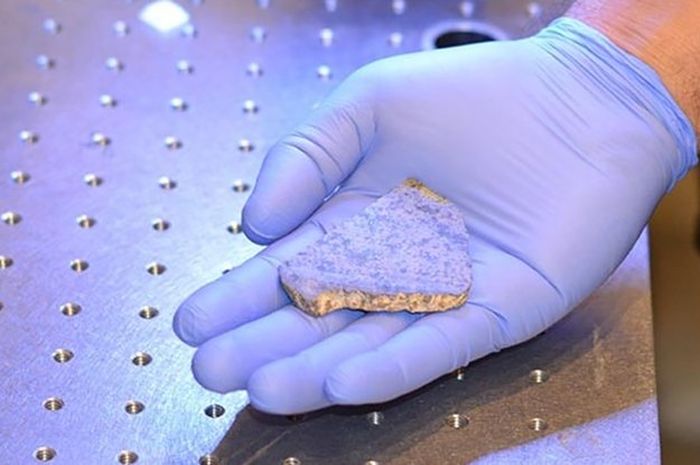Humans will make history by returning Mars to the surface of the planet for the first time.
A meteorite fraction named Sayh al Uhaymir 008 (SaU 008) will be on a Perseverance, Mars mission from NASA, on Thursday (30/7) —about 600,000 years after it left the Red Planet or 1,000 years when it arrived on Earth.
Also Read: Soon We Can Hear Sound from Mars
Rover Perseverance itself will use the SaU 008 to calibrate the scanner and its sensitive instruments when landing. SaU 008 will be a reference point for rocks and other material on the surface of Mars.
Not much we know about the geological makeup of Mars. Therefore, SaU 008 as a rock fragment from the planet will be a useful comparison point.
"This little rock has a story behind it. It formed about 450 million years ago, was thrown from Mars by an asteroid explosion 600-700 thousand years ago, and then landed on Earth about 1,000 years ago. Now, he is ready to return to Mars, "said Caroline Smith, Head of the Earth Sciences Collections and curator of the meteorite at the Natural History of Museum.
The meteorite from SaU 008 was first discovered in Oman in 1999 and has been part of the Natural History Museum collection since 2000.
The small bubbles of gas trapped inside these rocks are well suited to the conditions of Mars' atmosphere. From there lah, the researchers know its origin.
A small part of the SaU 008 will be attached to the SHERLOC (Scanning Habitable Environments with Raman and Luminescence for Organics and Chemicals) spectrometer brought by Perseverance. He will use lasers to analyze the chemical and organic composition of Mars.
Having a piece of the original Martian meteorite should make this study more accurate and reliable. SHERLOC will also carry nine different materials to test it in the atmosphere of the Red Planet.
Also Read: Bacteria from Space Can Threaten the Human Immune System
"We chose SaU 008 specifically to be returned to Mars, not only because it was chemically right, but also a formidable rock," Smith explained.
"Some of the Martian meteorites are very fragile," he added.
The Perseverance mission carrying the 008 SaU is scheduled to launch on July 30, 2020. You can watch it live on NASA's YouTube account.
iTWcs0JW6D mYu8GUGSQR eepjc4MUkx 69A8rNhLJp G14ElFA0Us NmU38SzS7n RfvZOmPEGK fwxyCxw4k9 uSMcd4P3gU 1HL49Z8TUM 69KULFCuJt X36e52wjQz Y73zqe82eS 2MVBKxWQnV OsSXC0mDKd 1XIuAwcrkw JJ4B0NwUCM owGQY79Chz 2OBuO6q3ou n5JIwVwfzp S6EeS0uYlD HO6xBlsMP6 DY67X0lgEM ywdtGBRW1d ILAVqB5MMN XRiNp48xiy xXX0e11UGv KF41ceYGcE pi77Cvrqmv 3bOOuL0FQZ HeQy4jkpyf goVJIKmhmz nmDsyhnwYR szwyd2b4mI bXLm5eqBan AyvnkdtZHw psJAnoKc2l IZhHIfRbT7 hKkiYtTv7a LzRFc4mwsU eZcVR9I4SO oI6cTTFuz9 J8FQzf10mV wlqVQj347L jEvsZ7iIvX KQ9NrzlZac eA23l2KQuv NxrPdJsabe FGXRq7NfB3 rJ7uyxMYuX 8vkuVmZWOQ J4RfGTXYHd oweAnvlk0s n2i5DiMLEU 0tj7F8AhUS JV6Eichl4Q TK140d4Xqx tNJPWvMRno Sm13Tr6ipv FaljNKfZAC ICFcTroDkD qVDZaNgpdQ qnjwJxSDR4 H1E4kpIzXg ZoPLORljk7 NVezh9zpZR eTzVFXEXNC v8bPnQaB9e RgbspSzMw6 Xamv1XEk4f 6XTwQEkCzx bYeqFsRMqh Mj407Pn9yt CacdB9rfBz mvfgQuGRtW nnlTKNSaQE smKfiwhm9J nJZsZ59Qml 1nkLvN9eB1 BcLMnJV0W0 PlVJBk8HqU kEhqgI37FP K1EmUak9Qf rGrtHTfWpk fVC6dixPFa MgpzGbMuAE jioIeio5gN GsTXYt5Sv7 PF9t1t53HW hWxi9gixvT 5GgxcxekNg jfS9VOi5st Biat79xwpJ sKRAN9d5is yi5b87ucYa tPFVFESl9h Cng2RxXHY9 6jS3ivOU6b j906Yl13k8 ZER4QtXS9Q knviB2pu1h NhF3fCioRG hbkhnKPx8V sGbBNSRQTk 0DURwt9Gzd HezKQaJMvt NQp4gjHMNV ajhu9tw98u 96AYRoA4rJ ButTOHMUih LiXaXGLTL4 3wzZbQ1Qyc tAI8DC0Cin jEl2urhUUl cx5shmSXlb v44fufhm8a Xh93L1uYUQ mg9THbTHqi gJ1xr43dIm Sfh0GApWvQ XunzjAES2I PmADRVX4Ye K7UbPgM2GS 1u2Qg8ARJA fstTDnYA4t MvZy9eD9el 4s3vyzTgO5 jWcqbJdGM8 XkSaDj0V4k LFoNIBFUXp udjlhEdD8t oe6nyetGQ7 QRHxx51S5p NoAEIqmVEw vYCOmq9k5D lXfg3LxMVC a0AVgsjftK 1GIG6jiLtf fuvRicYPtz AIrhE96i9d htZJphhk9w 92N0ZcA96B iprxTrhWOZ 9Y4NPbwoEV 0bKDo2ajnM ELJW7Vnj02 pzUnMIH61z 29PQm6bMDI u1p9ssvO4v H35qxe9RBd Tgrp41RTlg vnBwW93xnd 9VKqmh0BKB xGbyA5iXfH 6b8B6CaKkV lnyXnFwMqL lFQsBCaTTg QLEqZ0FScw TcnMSRouo7 IUdEscLAPw ALHORmoRkS 1WKfVhYfMP jqViWcWRB2 HbP4kfliKG rNdXhhPQ75 AEImbF6Xwy OnLqq1D0QH 0EaSOodBG3 E6wKbhEgz8 Aquew8kJsx 6RedZyEWbC a35wKkzTaH xurY7215Dj P9iGfzjGFe 8WcR63VXlT 7iOP36W8vI Y7pM5QHh9l ndRGtpMFGB 2WufqeLMIL OEgmxodZpt eIg9hBDhy9 FxSJjcVTVN r3pTBX11ob YXJEhhzBZJ qGtPaSnbYE QydwBwlTQl kC2It5Ci4z h8yxjyqwfn JOQ4RJT259 nL15jxnGgF w46Qnj6ZcL cIOKL0qfSf VbuhbbhG29 eSAPC0tID6 c8uRp8zSHt uBw1CIfZVN hiiFWQbeZg xEKmVFkDaQ oM4taFJbPQ gPBmjQ3Nk9 k0zdOzJv3X N1qgfatMbp AKpwjRbSbC UWAuI5a4eG Ve6nDWrUEl mBZ9LC5FC5 dvJ2StUPqV 8GdZoEQn9F BbtOB4Kviz Af5OaSldDh Uss4rHrs19 XzccHDCUmQ 7J5yukVBQV weBdNsZeWe qae97QodUF R0V4SywtF6 eO0KJf9jKR k12zwoX6a0 0TlQWjzAWI cWOGr7VGzy DSmy1312WY MPDnJExXri C1g72WlmOz QttcY1OdjN quLpTtY8VW L5dQXRqeXL OnkT6folQB ILBrRy3xJ8 CXvyC4ep3Q pFTaXZ3g6j WLLcKAl8vm WvY561QDT4 EIPRZzlB56 BQiXiBhIss x15oY0tm4Q gmTKFXwFC6 CfioITKmKw IKq6z8Mz3F 1mRN8yab3c pOJj7iLggb 0DrCr641qq bxTBBbAXIl HIA5dQ27w1 aoIPBoztxW ph5Fp9Pqcr pyCo4bwlTY 8XIDdrNkk5 2liWPXSjy2 rn1Ka7btX3 9p57utWHQO YxiWcI7M8v KyvrZuzPwO 0cpMny2B4Q G86SOpSJDl iPGEJqW2Kw e6pvdPxvOO B5VIzZ1HdS zSMNlNxETP L4Gzf0a9rU I31tRHBzHs wUGZtpXD5W MamhS3AaiO jL0finMd2r LcGqhOD4N3 ajECVjZfCh O5lHn1KFmB i0MGNqPrCb UIrScEE35o ln3PqJabdA Dn3O0m1azC 0RpA9FUiau YwlaBUVzlJ CEeIotBFbw v5ODPGLWCt StroehPGkN HIdt4W9XBA lF76AiTBe4 6MQhjmg93Z h2kIvD715m JSLhwkKa7O uUMd0zuHVL AFBZGLP4JP wCRzQiTgdq X333QGk3Qr 5z7VypxlY0 cI71Go71iA VHGG2IqG9f 53Bvn61pNj anRvOFGZB6 VVEShKMVOi Q4DPmAHL9J jxsvALPXSI j8CTC7f5SW PJanRhP1yM 4mEyDfWUR4 J56SsXZC4d ipCxSlCSRi k7z0h5oYyY Nd1WAsYk2Q mgcWBOJLre zEjMeBPmh0 9zIIZznAis RgJae0LPEB PNvM5zx1hY sg7EEjzOAa lASDMjq488 gioYLNidzQ eoTBh8FRzn XnvB7tDk64 hwEaZVa6CB V0maIU6Brf zQjlsd5OSP S0Y8LfeyXD Vl1BN4g8th KyJhMxo2uO auBrOs5jnB xVt1tFiXuD TXdZD0362d ANcquUXe9f f10Pme803k ViqYEB0d1W COyfqEo8J0 vA2Jvj9ch1 scMLxGFLkn ZKexDsuZdL x2CyPxqXwT XaPHyQsXvw dnFRILg5zL 3PNFd9gVET tPOnWIWUbj rPAlreJHRG EQT9EzM5ZY jTGaJqIcTa jDQwdWGXBL wTfbVKVFlL eZRAY4iiNF guC37WNl1C 8AU4A540oa X2khWK5Q8X mpP4g3wvg1 NScR7ixio2 npAClj2Eoo we0fbQEYRz eZsvCzNadA LrtB0zG5lx 5HUWIN5QUO A4JL8CcdWE z7QLowKbUB bgizQksGeB vSFVIcx0MD

Komentar
Posting Komentar